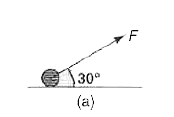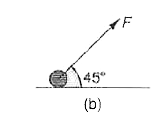In which of the following cases will the work done be maximum? The body is moved through a distance S on the ground




The correct Answer is:D
To determine in which case the work done is maximum when a body is moved through a distance S on the ground, we can use the formula for work done:
W=F⋅S⋅cos(θ)
Where:
- W is the work done,
- F is the force applied,
- S is the distance moved,
- θ is the angle between the force and the direction of displacement.
1. Identify the Formula:
The work done by a force is given by the equation W=F⋅S⋅cos(θ).
2. Understand the Role of θ:
The angle θ affects the value of cos(θ). The maximum value of cos(θ) is 1, which occurs when θ=0∘ (force and displacement are in the same direction).
3. Analyze Different Cases:
- Case 1: θ=30∘
W1=F⋅S⋅cos(30∘)=F⋅S⋅√32
- Case 2: θ=60∘
W2=F⋅S⋅cos(60∘)=F⋅S⋅12
- Case 3: θ=45∘
W3=F⋅S⋅cos(45∘)=F⋅S⋅1√2
- Case 4: θ=0∘
W4=F⋅S⋅cos(0∘)=F⋅S⋅1
4. Compare the Work Done:
- From the calculations:
- W1=F⋅S⋅√32
- W2=F⋅S⋅12
- W3=F⋅S⋅1√2
- W4=F⋅S⋅1
5. Determine Maximum Work Done:
Since cos(θ) decreases as θ increases, the maximum work done occurs when θ is at its minimum, which is 0∘. Thus, the maximum work done is:
W4=F⋅S
Conclusion:
The work done is maximum in the case where the angle θ is 0∘ (Case 4). Therefore, the answer to the question is Option 4.
- W is the work done,
- F is the force applied,
- S is the distance moved,
- θ is the angle between the force and the direction of displacement.
The work done by a force is given by the equation W=F⋅S⋅cos(θ).
The angle θ affects the value of cos(θ). The maximum value of cos(θ) is 1, which occurs when θ=0∘ (force and displacement are in the same direction).
- Case 1: θ=30∘
W1=F⋅S⋅cos(30∘)=F⋅S⋅√32
- Case 2: θ=60∘
W2=F⋅S⋅cos(60∘)=F⋅S⋅12
- Case 3: θ=45∘
W3=F⋅S⋅cos(45∘)=F⋅S⋅1√2
- Case 4: θ=0∘
W4=F⋅S⋅cos(0∘)=F⋅S⋅1
- From the calculations:
- W1=F⋅S⋅√32
- W2=F⋅S⋅12
- W3=F⋅S⋅1√2
- W4=F⋅S⋅1
Since cos(θ) decreases as θ increases, the maximum work done occurs when θ is at its minimum, which is 0∘. Thus, the maximum work done is:
W4=F⋅S
The work done is maximum in the case where the angle θ is 0∘ (Case 4). Therefore, the answer to the question is Option 4.
Topper's Solved these Questions
Similar Questions
In which of the following case of work done by a force will be maximum : when the angle between the direction of force and direction of motion is 0∘ or 90∘ ?
View Solution(a) Which of the following does the most work : a force of 3N acting through a distance of 3 m or a force of 4N acting through a distnace of 2m?
(b) How much work is done by the centripetal force?View Solution
Knowledge Check
- Question 1 - Select One or More
In which of the following cases no work is done by the force?
A(a) A man carrying a bucket of water, walking on a level road with a uniform velocity.B(b) A drop of rain falling vertically with a constant velocity.C(c) A man whirling a stone tied to a string in a circle with a cosntant speed.D(d) A man walking upon staircase - Question 2 - Select One
In which of the following cases can the work done increase the potential energy?
A(a) Both conservative and non-conservative forcesB(b) Conservative force onlyC(c) Non-conservative force onlyD(d) Neither conservative nor non-conservative forces. - Question 3 - Select One
In which one of the following cases of motion are the distance moved and the magnitude of displacement equal ?
AA car moving in a circular pathBA pendulum oscillating to and fromCThe earth revoling around the sunDA car moving on a straight road
(a) When do we say that work is done ? Write the formula for the work done by a body in moving up against gravity. Give the meaning of each symbol which occurs in it.
(b) How much work is done when a force of 2 N moves a body through a distance of 10 cm in the direction of force?View SolutionHow much work is done when a force of 1 N moves a body through a distance of 1 m in its own direction ?
View SolutionIn which one of the following cases of motion are the distance moved and the magnitude of displacement equal ?
View SolutionIn which of the following cases of motion, the distance moved and the magnitude of displacement are equal ?
View SolutionIn which of the following cases of motions, the distance moved and the magnitude of displacement are equal?
View Solution

